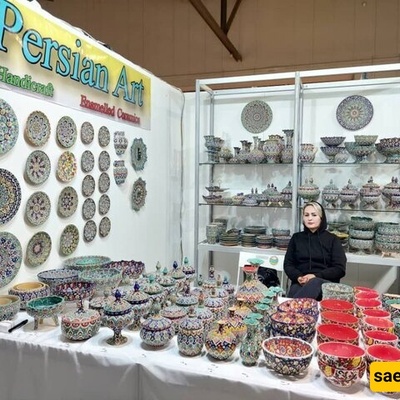The art of Toten weaving is an art that originates from Sistan and Baluchestan, made from strong plants, and in this article, we will get acquainted with it on Saed News. Stay with us.

The plant used for Toten weaving is called "Tutek." Toten boats were mostly used during times when the water level of Lake Hamun rose significantly, making it difficult for people to cross the lake. These Toten boats were compact and lightweight, making it easier for people to cross the water. Toten weaving is one of the traditional handicrafts of Sistan and Baluchestan. It involves creating a Toten boat, typically woven from sturdy plants growing around Lake Hamun, which are then prepared for use. Toten boats are mainly used by fishermen and villagers around the Hamun wetlands, particularly near Mount Khwajeh and the Takhteh Adalat area in Sistan.
The Toten boat, a century-old craft from Sistan, was once commonly found on the bed of Lake Hamun. Today, it awaits revival so it can return to the water. During the high-water period of Hamun, fishermen and those crossing the lake used the Toten boat made from Tutek plants.
The reeds growing in the marshes around Lake Hamun are used for Toten weaving. These reeds, called Tutek, are wild plants that typically grow from the beginning of Farvardin (the first month of the Persian calendar) until the end of Tir (the fourth month). Weaving a Toten boat is a challenging task, with its own special steps. One of the most difficult stages is harvesting the Tutek plants. However, since these plants are wild and close to the homes of the locals in Sistan, the cost of materials is minimal. After harvesting the Tutek, they need to be dried in the sun for three or four days. Once dried, the reeds are moistened slightly with water to make them more flexible and prevent them from breaking during the weaving process. After this, the two beams that connect the Toten boat are made, and the top and bottom of the boat are defined. Finally, hooks are created on the sides of the boat, and the Toten is ready for use.

Toten weaving refers to making boats known as Totens. Typically, when the water level from Afghanistan's dams rises, certain areas of the wetland are filled for several months, turning Toten boat rides into a popular leisure activity. Therefore, Toten weaving was extremely useful while the Hamun lake had water. Fishing, livestock raising, and hunting thrived during these times, and the Toten played a crucial role as a transportation tool for locals. Without these boats, farmers and fishermen had no way to move livestock, transport feed, or engage in fishing and hunting activities. This made Toten weaving an essential craft and a livelihood for the people. Nowadays, as Lake Hamun has dried up, Toten boats are typically made in Mazandaran and brought to this region. However, some Toten boats are still used in the water-rich parts of Hamun and the Hirmand lake, though large and small Totens are no longer seen on Lake Hamun.
The people of Sistan continue to preserve this ancestral tradition by holding annual Toten riding competitions, making it a joyous occasion. If you visit Sistan today, you will find that local artisans use Toten weaving to create small, decorative Totens, decorating their homes with these crafted boats. This shows that the people of this region are still striving to preserve this ancient art.
We hope this art remains alive among the people and in the waters of Lake Hamun.

